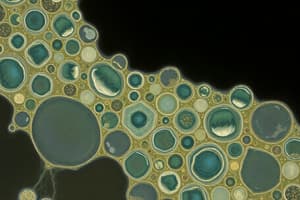Podcast
Questions and Answers
What is the primary difference between prokaryotic and eukaryotic cells?
What is the primary difference between prokaryotic and eukaryotic cells?
Prokaryotic cells are simple and lack a nucleus, while eukaryotic cells are complex and contain a nucleus.
List two functions of the cell membrane.
List two functions of the cell membrane.
The cell membrane controls the movement of substances in and out of the cell and provides protection to the cell.
What role do mitochondria play in a eukaryotic cell?
What role do mitochondria play in a eukaryotic cell?
Mitochondria are responsible for energy production by generating ATP through cellular respiration.
Describe two types of connective tissue and their functions.
Describe two types of connective tissue and their functions.
What is the significance of the cell theory in biology?
What is the significance of the cell theory in biology?
Explain the process of mitosis and its outcome.
Explain the process of mitosis and its outcome.
Identify two types of epithelial tissue and their locations.
Identify two types of epithelial tissue and their locations.
What is the primary function of ribosomes in a cell?
What is the primary function of ribosomes in a cell?
Flashcards are hidden until you start studying
Study Notes
Cell Biology
- Definition: Study of the structure, function, and behavior of cells, the basic units of life.
- Cell Theory:
- All living organisms are composed of one or more cells.
- The cell is the basic unit of life.
- All cells arise from pre-existing cells.
- Types of Cells:
- Prokaryotic: Simple, no nucleus, unicellular (e.g., bacteria).
- Eukaryotic: Complex, contains a nucleus, unicellular or multicellular (e.g., plants, animals, fungi).
- Cell Structure:
- Cell Membrane: Semi-permeable barrier that controls the movement of substances in and out.
- Nucleus: Contains genetic material (DNA); controls cell activities.
- Cytoplasm: Jelly-like substance where cell organelles are located.
- Organelles:
- Mitochondria: Energy production (ATP).
- Ribosomes: Protein synthesis.
- Endoplasmic Reticulum (ER):
- Rough ER: Studded with ribosomes; synthesizes proteins.
- Smooth ER: Lacks ribosomes; synthesizes lipids.
- Golgi Apparatus: Modifies, sorts, and packages proteins and lipids.
- Lysosomes: Digests waste materials and cellular debris.
- Cell Division:
- Mitosis: Process of somatic cell division resulting in two identical daughter cells.
- Meiosis: Process of gamete formation resulting in four non-identical daughter cells.
Tissue
- Definition: Group of similar cells that work together to perform a specific function.
- Types of Tissues:
- Epithelial Tissue:
- Covers body surfaces and lines cavities.
- Functions in protection, absorption, secretion, and sensation.
- Types: Simple (single layer), Stratified (multiple layers), Squamous, Cuboidal, Columnar.
- Connective Tissue:
- Supports, binds, and protects other tissues.
- Types: Loose (areolar), Dense (tendons, ligaments), Adipose (fat), Blood, Bone.
- Muscle Tissue:
- Responsible for movement.
- Types: Skeletal (voluntary), Cardiac (involuntary, heart), Smooth (involuntary, organs).
- Nervous Tissue:
- Composed of neurons and glial cells.
- Responsible for transmitting electrical impulses and processing information.
- Epithelial Tissue:
- Tissue Repair and Regeneration:
- Regeneration: Replacement of damaged tissue with the same type of cells.
- Fibrosis: Replacement of damaged tissue with scar tissue (fibrous connective tissue).
Cell Biology
- Study of cells, the fundamental units of life, examining their structure, function, and behavior.
- Cell Theory outlines three main principles: all organisms are made of one or more cells, the cell is the basic unit of life, and cells arise only from pre-existing cells.
- Types of Cells include:
- Prokaryotic Cells: Simple structure without a nucleus, typically unicellular (e.g., bacteria).
- Eukaryotic Cells: More complex, containing a nucleus, can be unicellular or multicellular (e.g., plants, animals, fungi).
Cell Structure
- Cell Membrane: Semi-permeable barrier regulating substance movement in and out of the cell.
- Nucleus: Houses genetic material (DNA) and controls cellular activities.
- Cytoplasm: Gel-like substance where organelles reside.
Organelles
- Mitochondria: Generate energy in the form of ATP, known as the powerhouse of the cell.
- Ribosomes: Sites for protein synthesis critical for cell function.
- Endoplasmic Reticulum (ER):
- Rough ER: Embedded with ribosomes, assembles proteins.
- Smooth ER: Lacks ribosomes, synthesizes lipids and detoxifies certain chemicals.
- Golgi Apparatus: Modifies, sorts, and packages proteins and lipids for transport or secretion.
- Lysosomes: Contain digestive enzymes to break down waste materials and cellular debris.
Cell Division
- Mitosis: Cell division process that produces two identical daughter cells for growth and repair.
- Meiosis: Specialized division producing four genetically diverse gametes for reproduction.
Tissue
- Definition: A collection of similar cells coordinating to perform specific functions.
- Types of Tissues:
- Epithelial Tissue: Protects body surfaces and lines cavities; functions include absorption, secretion, and sensation; can be classified as simple or stratified, and squamous, cuboidal, or columnar.
- Connective Tissue: Supports and binds other tissues; includes loose (areolar), dense (tendons, ligaments), adipose (fat), blood, and bone varieties.
- Muscle Tissue: Responsible for movement; includes skeletal (voluntary), cardiac (involuntary, heart), and smooth (involuntary, organs) tissues.
- Nervous Tissue: Comprised of neurons and glial cells; involved in transmitting electrical impulses and information processing.
Tissue Repair and Regeneration
- Regeneration: Replacement of damaged tissue with identical cell types.
- Fibrosis: Repair by replacement with scar tissue, a form of fibrous connective tissue.
Studying That Suits You
Use AI to generate personalized quizzes and flashcards to suit your learning preferences.




